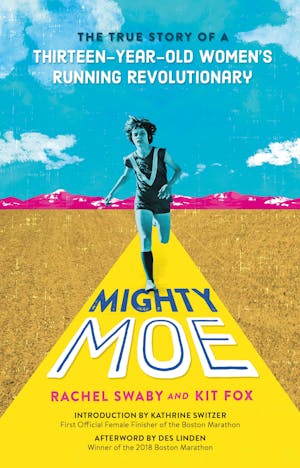1
The girl shouldn’t be here.
Not on this dusty road north of Toronto, next to the fields filled with wildflowers and the newly constructed brick college buildings. Not alongside the twenty-eight men dressed in shorts and T-shirts and running shoes. The men are clustered away from the girl, stretching and shaking out their long arms and legs. They’re tall, all of them towering like trees at least a foot above her. As they chatter and touch their knees to their chest, reach for their toes, or slowly jog in relaxed circles, the girl feels like she’s standing on the edge of a forest.
On this late-spring Saturday morning, the girl should be at home, ten minutes down the 401 freeway, listening to her favorite records on the dresser-sized wood-paneled hi-fi stereo in her parents’ living room. She should be lying on the rust-colored carpet, her hands clasping her chin as her foot taps to the beat of a song by the Monkees or the Beach Boys as she daydreams about curling waves on a California beach.
Or she should be at the family property on Doe Lake, two hours north of here. By this point in the morning, she’d be in the water, cutting through the wake behind her parents’ small aluminum motorboat on a slalom water ski. Or she’d be leaping off the giant rock out beyond the dock into the cold fresh water, trying to avoid getting splashed or dunked by her older brothers.
She should be riding her bike. She should be licking a chocolate-dipped cone from Dairy Queen. She should be doing homework, reading a book, or talking on the phone with a friend. She should be doing any one of the thousands of things a thirteen-year-old girl in 1967 from North York, Ontario, should be doing on a Saturday morning in May.
She’s too short, too small, too young, and too, well, too much of a girl to be here.
Or at least that’s what grown-ups have been saying for decades. In conference rooms and meeting halls and all the places where important adults—mostly men—decide official things about the sport of running. They declared that a girl should not be allowed to be here awaiting the start of this race with dozens of male contestants, a race that will go on for hours.
Actually, these official men haven’t just decided that a girl like her shouldn’t be allowed to try something like this. They’ve decided she couldn’t do it even if they let her. It isn’t possible. If she tried, they’ve proclaimed, it could damage her forever.
But the girl is still here—all four foot eight inches and eighty pounds of her—trying desperately not to catch the attention of the men as she ties her Puma shoes next to her mom’s car.
Yes, the girl is here. And she is going to try to break a world record.
Though if you happened to be walking on Steeles Avenue in the Toronto suburb of North York, you wouldn’t know a world-record attempt was about to happen. Which was strange. A world record is supposed to be momentous, historic. There’s supposed to be fanfare and cameras and swelling crowds hoping to glimpse something that’s never happened before.
Nine months earlier, three thousand miles southeast of here on a track at UC Berkeley in California, a University of Kansas student named Jim Ryun broke a world record, and he got all that. He ran a mile around a track in three minutes and fifty-one seconds. Millions of people watched it on TV during ABC’s Wide World of Sports; hundreds more witnessed it live. They screamed and clapped as Ryun’s torso broke through a piece of string at the finish line.
There aren’t any TV cameras here to broadcast the girl’s record attempt. Just a few dozen people ambling around a registration table on the sidewalk. A wooden stake has been hammered into the grass. Stapled onto it is a small sign that reads MARATHON START in black handwritten letters.
The girl is standing off to the side with her mom. She is about to do, essentially, the same exact thing as Jim Ryun—run. But she’s going to run thousands and thousands of steps farther than him—about fifty-two thousand to his two thousand. That means running for more than three hours, instead of more than three minutes.
Many of the grown men milling about in front of the starting line don’t know she’s going to do this. They are all listed on the event’s program as official entrants in the Eastern Canadian Centennial Marathon Championships. Their names are on the second page in blue letters. There’s Al Sinclaire and Wendon Adey, both from Gladstone. Jim Beisty and Herb Monck of Hamilton. There’s Tom Miller and Tom Coulter from Syracuse, New York. There’s more than twenty other names listed: all men who aren’t afraid or nervous to be seen at a marathon starting line because they know they are allowed to be here.
The girl’s name isn’t listed with theirs. She’s farther down the page, beneath the section that says “12:00 Noon: Women’s Open 5 Miles.” That, according to those official adult men in ties and blazers, is a respectable distance for someone like the girl. And so that is what the program says she is going to do: run five miles with twenty-two other women.
The marathon is scheduled to start five minutes before the women’s race. “You need to get to the start line,” the girl’s mom says sternly, in the same tone of voice she uses when she tells the girl to clean her room.
But the girl isn’t ready yet. She’s nervous, and a little embarrassed. Not because she is about to run a marathon. She knows she can do that. She’s been training for three years and knows what it feels like to run really long and really fast.
She’s nervous what the men will think when she walks up to that starting line. What will they say? What will they do?
She inhales deeply. Then marches toward them.
As an experienced runner, she’s completed a version of this routine hundreds of times before—the moments just before a race when everything seems quieter than it actually is, when you can hear your own heartbeat pulsing in your ears. It feels familiar in a way that helps her forget about those men and what they might say. It’s another race, she thinks. Just another race.
She steps up toward the runners now gathering at the starting line. She jiggles her legs, shakes out her arms. She ignores the curious looks and smiles from some of the other participants.
“Runners, take your mark.”
The girl takes a breath. Relax. Relax. It doesn’t matter if she’s not supposed to be here. She has a job to do. She has a record to break.
“Set.”
Another breath. There’s silence. The girl’s muscles clench. She leans forward. Her fists are balled and her eyes are focused straight ahead.
Crack!
The sound of the starter’s pistol pierces the air. The girl begins to run.
2
On November 30, 1953, the temperature in Toronto held just above freezing. Toronto Western Hospital, a tall brick building just over a mile north of Lake Ontario, stood among dull cloud cover. But inside the hospital, the weather didn’t matter—not to Margaret and Roger Wilton. They were busy studying the folded legs, stretching fingers, and tiny, serious face of their newborn daughter.
Margaret Maureen Wilton was named after her mother, but they planned to call her by her middle name, Maureen. No one knew the way her life would shape the world just then. She was notable in the Wilton family because she was smaller than her two older siblings had been at birth, just five pounds, and a girl. A first for Margaret and Roger, who already had two boys, Gordon, six, and Dan, two and a half.
They brought Maureen home to a flat in the West End of Toronto. The Wilton family lived on one floor of an old brick house owned by Maureen’s great-aunt. Maureen learned to crawl, walk, and run in this house. She danced through the kitchen and living room with her brothers and dressed up in cowboy hats. In the months without snow, Maureen charged around the uneven sidewalks on her metal tricycle and played with a boy next door. When the temperature plunged below freezing, Roger Wilton made a small ice rink in the backyard for the kids to play on.
Text copyright © 2019 Rachel Swaby and Kit Fox






